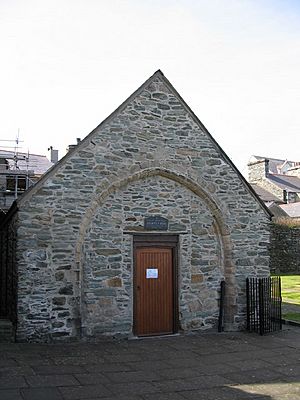Eglwys y Bedd facts for kids
Quick facts for kids Eglwys y Bedd |
|
|---|---|

The entrance to Eglwys y Bedd, through what was once the chancel arch
|
|
| Lua error in Module:Location_map at line 420: attempt to index field 'wikibase' (a nil value). | |
| Location | Holyhead, Anglesey |
| Country | Wales, United Kingdom |
| Website | St Cybi's Church website |
| History | |
| Founded | 14th century |
| Architecture | |
| Heritage designation | Grade II |
| Designated | 26 September 1951 |
Eglwys y Bedd is a very old church building in Anglesey, north Wales. Its name means "Church of the grave" in Welsh. Sometimes, it's also called Llan y Gwyddel, which means "Church of the Irishman."
This ancient building is all that remains of a church built in the 1300s. It stands within the churchyard of St Cybi's in Holyhead. People believe it might be built on the very spot where Cybi, a Celtic saint from the 500s, lived and worked. There's also a cool legend that it holds the grave of Seregri, an Irish warrior from the 400s.
Eglwys y Bedd is a special place. It's a Grade II listed building. This means it's considered very important and efforts are made to protect it. In the 1700s, it became the first school in Holyhead. Today, St Cybi's Church uses it as a church room.
Contents
A Look at Its History
Eglwys y Bedd is a medieval building. It sits in the southwest corner of the churchyard of St Cybi's. Holyhead is a major port in Anglesey, north Wales.
Saint Cybi and the Roman Fort
Cybi was a Celtic saint who settled in Holyhead. The Welsh name for Holyhead is Caergybi, which means "the fort of Cybi." Eglwys y Bedd might mark the exact spot where Saint Cybi had his cell. A cell was a small room or hut where a holy person lived and prayed. The building is also inside the walls of an old Roman fort called Caer Gybi.
Changes Over Time
Archaeologists dug here in 1992. They found signs that an even older medieval building was on this site before. The Eglwys y Bedd we see today was built in the early 1300s. It used to be much bigger! The current building is only the main part, called the nave, of a larger church. The rest of the old church is gone.
By 1748, the building was in ruins. Then, Thomas Ellis, who was the rector (a type of priest) of St Cybi's, fixed up the nave. He turned it into the very first school in Holyhead. Later, in 1810, the ruined chancel (the part of the church near the altar) was completely removed. After more restoration work in 1980, Eglwys y Bedd is now used as a church room by St Cybi's.
The Legend of Seregri
There's a famous story about Seregri, an Irish warrior from the 400s. People say he is buried here. Seregri led a group of Irish warriors who had settled in Anglesey. They were eventually driven out by a Welsh ruler named Cadwallon Lawhir ap Einion.
In 1833, a historian named Angharad Llwyd wrote about Eglwys y Bedd. She reported that when parts of the ruins were removed, a stone coffin was found. It was on the north side of the chapel where Seregri was supposedly buried. This coffin contained "human bones of a prodigious size." This adds to the mystery and legend of the place!
What It Looks Like
Eglwys y Bedd is about 26 feet 9 inches long and 14 feet 6 inches wide. It is built with grey stones and has a roof made of slate.
At the west end of the building, there is a window from the 1300s. Below this window, there's an old doorway from the 1400s or 1500s that is now blocked up. At the east end, you can see the chancel arch. This archway has cool decorative work from the 1300s. The north side of the building has two square windows.
Why It's Important
Eglwys y Bedd is recognized nationally as an important building. It has legal protection from being changed without permission. This is because it's a Grade II listed building. This is the lowest of three grades, but it still means the building is special. It's worth making every effort to keep it safe and preserved. It was given this special status on September 26, 1951.

